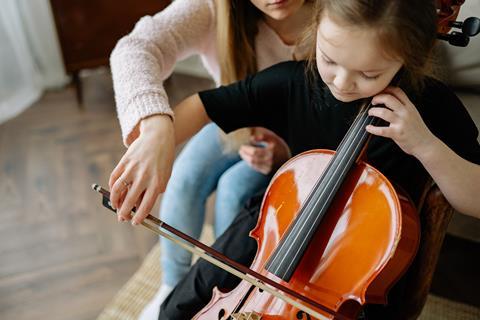Philippa Bunting looks at the scary economics of learning and teaching a stringed instrument

Discover more Featured Stories like this in The Strad Playing Hub.
This article was first published in the December 2011 issue of The Strad
If money doesn’t actually make the world go round, it does, to mix a metaphor or two, keep the show on the road and food in the fridge. It’s also the theme of this issue of The Strad, so here are some thoughts on the financial aspects of string teaching.
We may regard the relationship between economics and education as rather a grubby one, but one thing is certain: becoming a string player is expensive. As with parenthood, a long, hard examination of the figures might well dissuade some from starting out at all. Of course, that’s no way to look at it, but it does throw the scale of the issue into sharp relief.
Let’s take a child at the end of a year’s free tuition in a whole-class situation. She’s keen, and wants to carry on playing. Her parents are looking at finding an instrument – perhaps hiring one – along with some music and a weekly group lesson at school. I estimate that that package would work out at about £250–£300 a year. Not too bad.
Would you baulk at a total of £50,000 to get a child who starts at 6 as far as 18?
But what about further along the road, where the parents are now perhaps looking at individual tuition, if they haven’t from the outset? Things start to get slightly more scary. At this level – a 30-minute individual lesson; a better instrument and bow; a few other bits and bobs – I estimate parents are scrabbling down the back of the sofa for upwards of £3,000.
Fast forward: an hour’s lesson a week, another instrument upgrade, a case, accessories, more music, exam fees, festivals, courses, orchestras, ensembles, and the cost could easily leap to £5,000 a year or more. You won’t find that kind of money down the back of any piece of furniture I’ve ever seen. Indeed, if you happen to be living in a mythical average household, it represents a whopping 50 per cent of your disposable income. That’s quite a commitment.
This isn’t a serious economic analysis by any means, but would you baulk at a headline total, based on the entirely unscientific figures above, of £50,000? That’s to get a child who starts at 6 as far as 18, and possible conservatoire entrance? Without piano lessons. Or the absolutely must-have items of music-related tat that music shops like to tempt us with. Or a music stand. Of course, nothing is ever quite as simple as the raw figures suggest, but they do focus the mind a little, particularly in these economically turbulent times.
Read: How should string teachers deal with naturally unmusical children?
Read: Sound quality should be the main focus of string teaching
So what about the pedagogue’s perspective? How does the economics of string teaching play out for us?
Some young teachers, starting out in their careers, deliberately set their charges low to drum up custom. Although they may be undercutting more experienced colleagues, that strategy seems reasonable, because the business of learning to teach can’t really start, let’s be honest, until you have your first guinea pigs. And it doesn’t seem fair to charge them at the full rate.
The flip side is that it can be hard then to increase that amount to make something more like a living wage. Let’s go back to some number crunching. The average individual wage in 2011 in the UK was approximately £26,000. At £30 an hour, that equates to around 866 teaching hours per year. If I teach for an average of 34 weeks a year, that means 25 hours of teaching each week, which, as a private teacher, I can achieve if I work 3 hours every day after school, and 10 hours over the weekend. If the average lesson for a child is 30 minutes, that’s 50 pupils per week. And 50 sets of parents. Tough gig.
Why not simply put the fees up? After all, some star teachers charge astronomical sums. Of course they need to guarantee results, or hide their failures in cupboards, but there’s clearly a demand. Some would say that charging high fees would in itself raise your status as a teacher, but on the other hand, it could drive your students away.
Finally, you can always, in the words of one enthusiastic blogger, ‘Learn online for free!’ One teacher I came across, who used to charge £130 an hour for face-to-face time, now makes his system available via YouTube for just £17. What are the economics of that, I wonder? Are our days numbered?
Do you have an opinion on the issues raised in this article? If you would like to get in touch, please email us at thestrad@thestrad.com
Read: How much should instrumental teachers push genuinely talented youngsters?
Read: Should string teachers embrace the latest fashions and gadgets?
Discover more Featured Stories like this in The Strad Playing Hub.
This article was first published in the December 2011 issue of The Strad
The number one source for playing and teaching books, guides, CDs, calendars and back issues of the magazine.
In The Best of Technique you’ll discover the top playing tips of the world’s leading string players and teachers. It’s packed full of exercises for students, plus examples from the standard repertoire to show you how to integrate the technique into your playing.
The Strad’s Masterclass series brings together the finest string players with some of the greatest string works ever written. Always one of our most popular sections, Masterclass has been an invaluable aid to aspiring soloists, chamber musicians and string teachers since the 1990s.
This year’s calendar celebrates the top instruments played by members of the Australian Chamber Orchestra, Melbourne Symphony, Australian String Quartet and some of the country’s greatest soloists.














































No comments yet